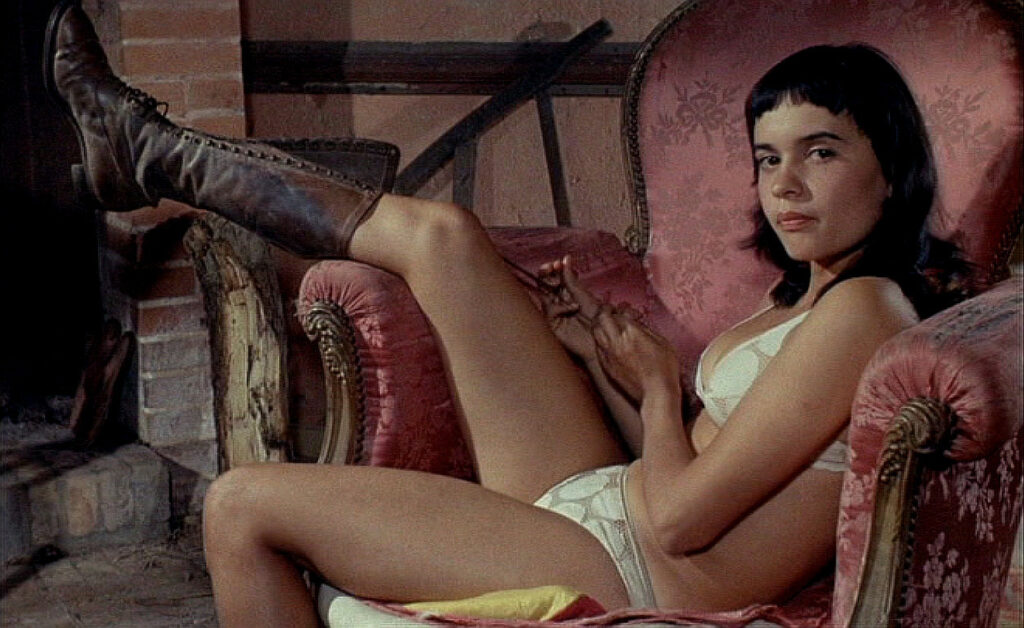
Mais ne nous délivrez pas du mal (1971) is loosely based on the murder of Honorah Parker by her daughter Pauline and her daughter’s friend Anne Perry in 1954. While Joël Séria’s film was neither the first nor last film to be inspired by this notorious murder case, it is the most infamous. Peter Jackson’s infinitely more popular film Heavenly Creatures (1994) is a far more faithful retelling of these tragic events that is rooted exclusively in the tradition of the horror film whilst Séria’s approach owes more to the artful eroticism of Alain Robbe-Grillet than to any particular genre.
Séria’s Mais ne nous délivrez pas du mal essentially uses the Honorah Parker murder case as a springboard for his own narrative. The basic premise of Mais ne nous délivrez pas du mal is that best friends and social outcasts Anne de Boissy (Jeanne Goupil) and Lore Fournier (Catherine Wagener) have, in opposition of the Catholic faith, given themselves over to committing as many sins as possible. They spend their summer ridding their bikes around the countryside causing mischief, getting into trouble, and performing satanic rites. In their Baal-like quest for fun, Anne and Lore wield their privilege and sexuality as weapons against the local farm hands and bourgeois commuters as a means of breaking the social and political shackles of their patriarchal milieu.
There are times when Mais ne nous délivrez pas du mal comes dangerously close to becoming little more than a Schulmädchen-Report film but Joël Séria’s deep sense of empathy for his anti-heroines negates this trap. Suffice it to say that Anne and Lore’s campaign is never truly successful. Gradually, Mais ne nous délivrez pas du mal reads more and more like a tragedy. For all of their cruelty and all of the bizarre situations that these school girls create, Séria never lets the audience forget that Anne and Lore are children. Any moment of exploitative titillation is countered with a harsh sense of reality that effectively deconstructs the fundamental nature and purpose of the sexploitation film.
It is the passionate friendship between Lore and Anne that hooks the audience early on in Mais ne nous délivrez pas du mal. However it is the constant threat of discovery and of reciprocity by the girls’ victims that make Mais ne nous délivrez pas du mal so thrilling. In this way Mais ne nous délivrez pas du mal is a kind of forerunner to films such as The Craft (1996) and a descendent of films like Mädchen in Uniform (1931). Although the destructiveness of the heroines and the subversive political sentiments of Mais ne nous délivrez pas du mal also recalls Věra Chytilová’s Daisies (1966).
Easy resolutions and success are denied in Mais ne nous délivrez pas du mal. When Anne and Lore realize that their arrest for murder is inevitable they conclude that their only option to negate the ramifications of their actions and remain true to their union is to commit suicide. This act of self-annihilation isn’t just a gesture of love for one another nor a means of escape. Anne and Lore commit suicide by setting themselves ablaze at the conclusion of a recitation of Baudelaire’s Les Fleurs du mal at their school talent show. The act of suicide in a public forum becomes a means of political protest that mirrors the self-immolation of Norman Morrison in 1965.
Where another filmmaker would dwell on sexual spectacle or turn the story of Anne and Lore into a cautionary tale in the name of conformity and preserving the status quo, Joël Séria opts instead to celebrate the doomed rebellion of his heroines. It’s this approach that made Mais ne nous délivrez pas du mal such a controversial film. To criticize the Catholic church is one thing, but to romanticize “satanist” school girls who martyr themselves in an anti-Catholic cause is quite another.
